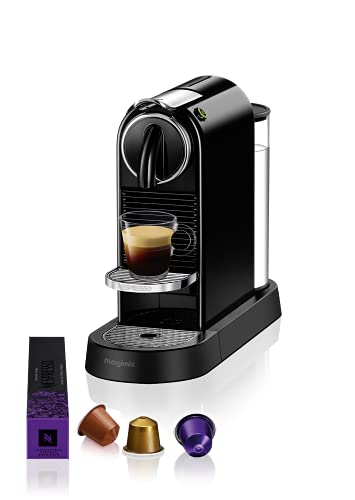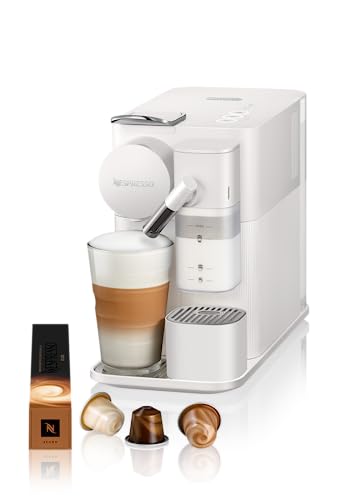10 Tell-Tale Signs You Need To Find A New Nespresso Coffeee Machine
관련링크
본문
 nespresso machine white Coffee - The Essenza Mini
nespresso machine white Coffee - The Essenza Mini The Essenza Mini is compact, inexpensive and user-friendly. It forgoes features like water tank or a drip tray that can be removed to remain small, yet it can make excellent lungo and espresso.
The Essenza Mini is compact, inexpensive and user-friendly. It forgoes features like water tank or a drip tray that can be removed to remain small, yet it can make excellent lungo and espresso.It is operated by piercing capsules and pumping hot water under pressure to create different espresso and coffee sizes, like the 1.35-ounce espresso, 2.7-ounce double espresso, 5-ounce gran lungo or 14-ounce alto. It can be used with a freestanding milk frother.
Capsules
With the Nespresso system you can brew your coffee at the press of a button. You can choose between a single-serving cup or a larger one and each capsule contains the right amount of beans to achieve the desired strength. You can also add milk powder to make cappuccino, latte macchiato, or other drinks. The capsules are made of biodegradable and non-toxic materials that can be disposed of or recycled in a way that is guilt-free.
The pods are made of aluminum and are able to stand up to the pressure of the machine. The pods are sealed and can't be tampered with. The coffee grounds stay fresh, safe from oxygen and moisture. Nestle's sustainability goals are aligned with the fact that aluminium is 100% recyclable.
However, the system is not without its flaws. For starters the machines cost a lot to purchase and operate. Additionally capsules are expensive to buy, and they need to be replaced regularly. The machines can only be used with capsules that are branded Nespresso. This has led to several lawsuits between Nestle and third-party firms that utilize the same extraction techniques and ingredients as Nespresso.
Despite these disadvantages, the Nespresso System offers many advantages. These include top-quality coffee and sustainability in the environment. It's a great alternative for regular tea and coffee, and it has an extraction rate that is higher than the majority of single-serve systems. One capsule can make up to 14 ounces of espresso-style coffee.
The first capsule design was developed in 1976, and it was first patented in 1979. The main characteristics of the capsule are an aluminum cone container and a flat top with a cylindrical recess, through which the machine can inject water, and a small opening in the bottom that's punctured both above and below. The capsule is spun at 7700 rpm by the machine to infuse water into the coffee to produce a thick, creamy crema.
Water
It is essential to use top-quality water when you use a Nespresso. This helps ensure consistent quality, and is crucial for taste and texture. Ideally, you should use water that has been "filtered" or "spring," and avoid tap or distilled water.
In our laboratory tests, we've discovered that Nespresso machines with high-quality softened water can make more enjoyable espressos and lungos than those that use hard water. Hard water can cause calcium deposits and other problems that can alter the taste of your coffee.
During each cup during each cup, the Nespresso coffee machine releases hot water under high pressure. This process is known as extraction. The duration, temperature, and pressure of the extraction process is what determines the taste and intensity of your nexpresso coffee maker.
The original machines pierce and then pump the capsule, while the Vertuo models operate by reading barcodes that are printed on the capsules to determine the amount of water required for a specific type of espresso. The Vertuo models can make six different drink sizes, including lungos and espressos, with or without a cap of foam.
All machines that are part of the nespresso coffe machines range produce 19 bars of pressure. Some of the more expensive models also make cappuccinos and latte macchiatos, and some even offer the option to make iced coffee.
Inissia machines and U-series machines are both compact making it easy to place them in tight areas. The Nespresso Pixie, which has an integrated frother, is another compact option. It can be paired with the app of Nespresso to get customized recipes and to reorder capsules. Nespresso is a good choice for anyone who wishes to reduce their carbon footprint and also support the company's sustainability program.
Temperature
Nespresso machines are more sophisticated than the typical coffee maker but they are also designed to be speedy and easy to use. They are extremely fast taking only a few minutes to prepare each capsule. They are also quite energy efficient. Unlike traditional drip coffee makers, which consume more electricity per cup of coffee, Nespresso machines only use only a tiny amount of energy to make each capsule.
Most Nespresso coffeee machine are designed for espresso-based drinks, but certain models come with milk frothers that can be used to make cappuccinos or lattes. Certain models come with a capsule container that can hold up to 12 used capsules at one time, which makes them easy to recycle.
The Nespresso brand is supported by a variety of well-known kitchen equipment makers, including Krups, DeLonghi and Breville. However the majority of machines are made by Eugster/Frismag the Swiss company that is one of the world's largest coffee-machine producers. This has prompted criticism of the company's use patents and other strategies similar to those used by printer manufacturers to create lock-ins for vendors.
Pressure
To achieve the best espresso, you must keep the same pressure throughout your extraction. This is referred to as "pressure profiling." Pressure profiling involves changing the amount of pressure applied to the coffee grounds to get the best extraction and maximize flavor. This method is possible by using various espresso machines, including Nespresso coffee makers.
There are a variety of different ways espresso machines manipulate pressure during the extraction process. A balanced bypass regulates water pressure to a certain number, usually 9 bars regardless of the inlet. This is a simple, efficient technique that guarantees that all of the espresso groups are at the same pressure during the extraction process.
A lever or control knob can be used to manually adjust pressure. This method is more difficult but it offers more flexibility and control. It is important to note that manual pressure regulation can result in inconsistent results, which is why it requires a high degree of skill and attention.
Additionally, some espresso machines utilize an electronic pump that adjusts the pressure based on the temperature of the ground and the type of coffee used. This is a more sophisticated system however, it can give better results than other types.
Nespresso offers a variety of machines that can be used to make coffee, lungo drinks and some are also able to froth the milk. The Nespresso Inissia is a great machine for baristas at home. It can make 7 to 9 espressos simultaneously and comes with a water tank of 33 ounces. It is also equipped with buttons for different sizes of drinks and includes the capsule tray, which can hold up to nine pods. The nespresso maker Vertuo Next is designed for versatility and features 11 milk temperatures as well as eight milk textures to choose from. It also comes with a stainless steel milk frother as well as the container that can hold up to 18 pounds.
Cleaning
If you use a Nespresso machine it will leave behind small mineral and limescale deposits each time you make a cup. These residues may mix with your coffee, causing it to taste sour. To avoid this, it is important to regularly clean your Nespresso coffee Maker machine and all its parts. A deep clean should include washing and descaling the removable parts, including the drip tray and capsule container. A daily rinse with fresh water can also aid in preventing the buildup of minerals and improve flavor.
De-scaling products can help you remove mineral deposits from your machine. These products are readily available in most outlets for coffee and appliances. Alternately, you can try vinegar. This versatile cleaner will not harm your machine, but it will take longer to dissolve the minerals than a descaling liquid.
If you choose to use vinegar, you must remove the coffee pods first, then empty the reservoir. Pour out all the remaining water in the tank including any filters. Pour in the vinegar and run a brew cycle without a coffee pod to allow it to pass through the machine. Rinse the machine with clean water, and run several times to ensure that there are no vinegar traces left.
After cleaning your machine, clean the exterior and the removable parts. Pay particular attention to the corners and crevices where gunk may get caught. Wash the removable parts in your dishwasher or hand wash them using mild soap and water, making sure to rinse thoroughly. Check the seals on the capsule and the coffee outlet and replace them if they are damaged to ensure their elasticity.

